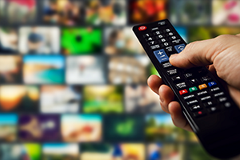
The Latest Hospital Digital Marketing Articles
GreyMatters is your hospital digital marketing guide, with articles on hospital digital marketing best practices, trends, updates and more.
Are Marketers Missing the Boat with Digital TV Advertising?
Gone are the days of “Must-see TV” where viewers watched network programming for several hours straight on one TV network on one particular day of the week. The audience for this form of TV viewing (linear TV) has decreased steadily over recent years with the advent and expansion of digital viewing options. 
While the COVID-19 pandemic increased the amount of time people spent viewing video content, linear TV was the loser as viewers turned more and more to digital content. Even big TV events like live events, awards shows and sports have lost live viewership in the tens of millions since 2014. But it’s not so much because people are no longer interested in these programs – it’s because they want to watch when they want to watch, not when some random network programming executives say to watch.
Most marketers understand they should have a digital-first approach when it comes to TV/video ads, but they often still cling to certain myths regarding linear TV, such as:
- Marketing modeling gives linear TV a thumbs-up. Marketing mix modeling (MMM) may still indicate that linear TV advertising is more effective than digital alternatives. However, because of the way these models work (backward-looking), they’re not accurate indicators for real-time factors such as changes in consumer behaviors related to format, pricing or even changes to the media itself.
- Mass reach requires linear TV. This myth persists even though data proves it wrong. Considering that 213 million people in the US watch streaming programming via connected TV apps, TV advertising is crucial in the digital space.
- Only “premium” content counts. The growth of digital has blurred the lines of what constitutes “good content.” Today, consumers want video content that relates to their passions. Only 15% of consumers say that TV content should be produced professionally.
- Only linear TV provides a big-screen experience. Connected devices mean that digital content can be watched anywhere, even on actual TV screens. During the year between 2019 and 2020, the amount of YouTube watch time on TV screens doubled. Thus, linear TV is not required for the big-screen viewing experience.
- Low cost per impression (CPM) isn’t necessarily a good metric. TV ads traditionally have had a low CPM and when considered against connected and streaming inventory that’s more costly, they may seem to be a better deal. However, digital ads provide more bang for the buck.
If your organization is thinking of upping its digital video advertising game to get to a digital-first mentality, here are some steps to take to get started:
- Try creative freedom for a campaign. While you want to be consistent with messaging, etc., try doing something a little different for a campaign and monitor the results. Example: when launching a new product, one brand targeted seven different audiences with 30 varying creative cuts and achieved a 12% increase in sales over previous campaigns based on linear TV.
- Coordinate digital and TV for maximum reach. For example, to coordinate a campaign across linear TV and YouTube, consider Nielsen’s Total Ads Rating (TAR) data, which measures results across multiple platforms, to determine the appropriate mix.
- Be the big fish in a small pond. Try a campaign on a small scale or in a smaller geographic region.